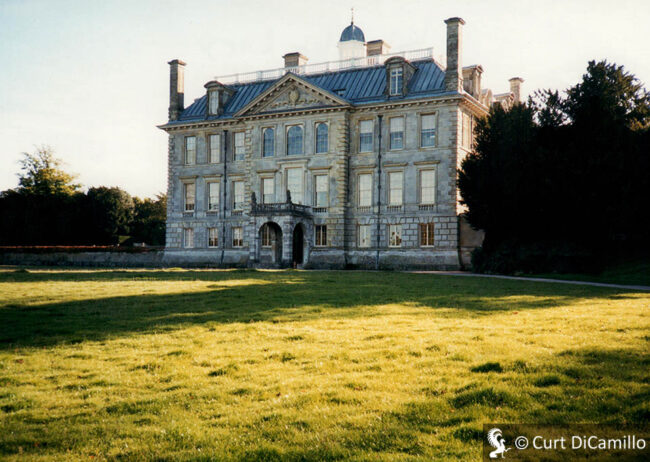
The entrance facade in 1999
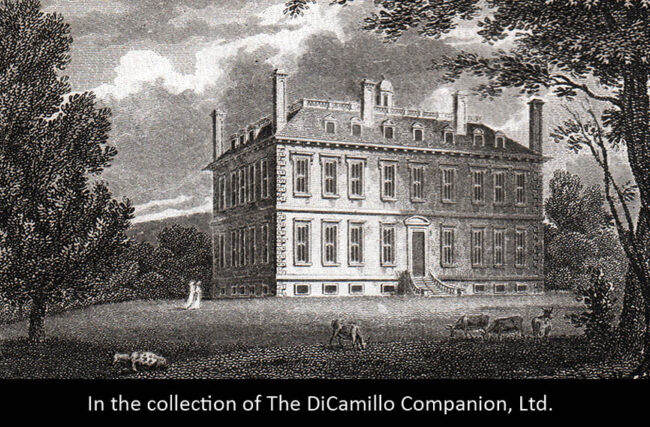
Coleshill House, Oxfordshire, from an early 19th century engraving. This influential early 17th century house, also by Pratt, was hugely important in the design of Kingston Lacy House.
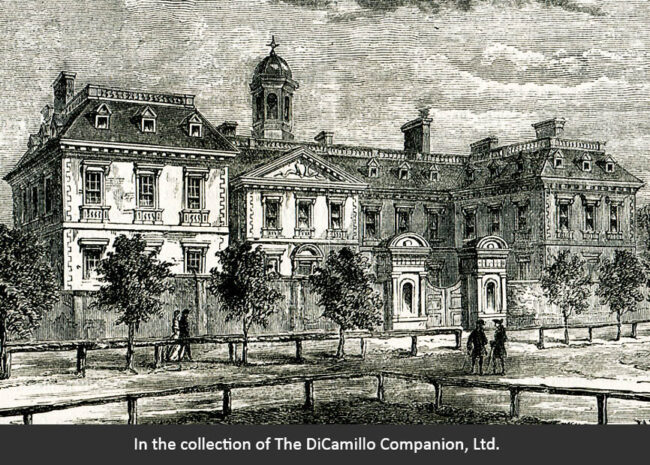
Clarendon House, London, which probably influenced the design of both Kingston Lacy House and Coleshill House.
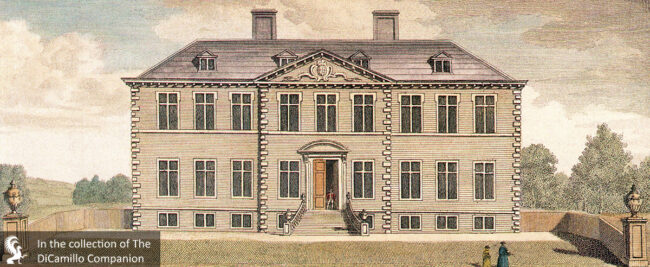
Kingston Lacy's entrance facade as it appeared in the late 18th century (from a 1774 hand-colored engraving), when the house was called Kingston Hall.
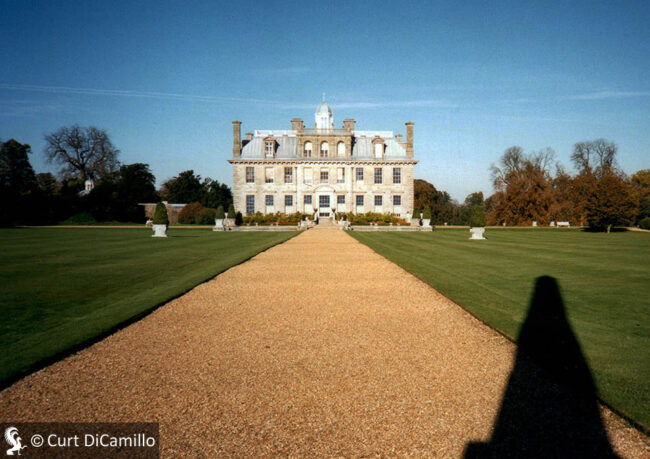
The garden facade, with the shadow of the Philae Obelisk at lower right.
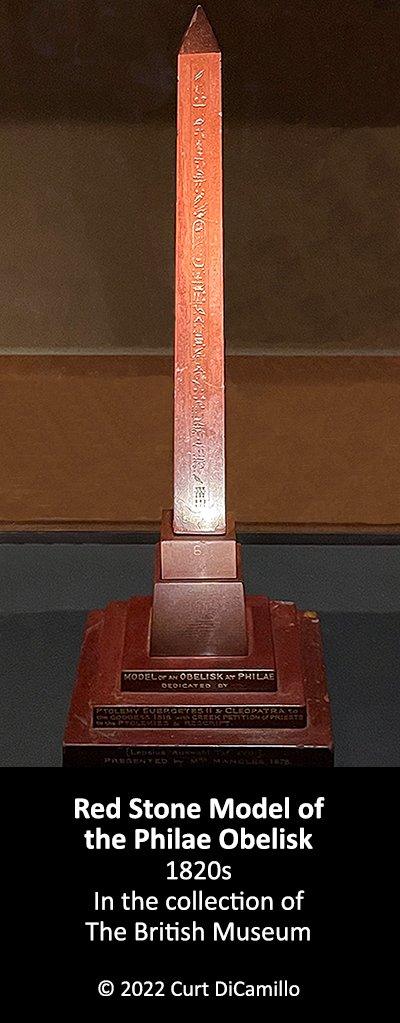
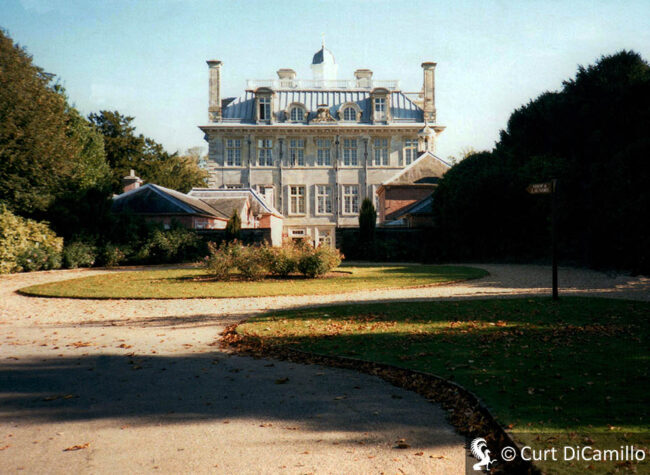
Side facade
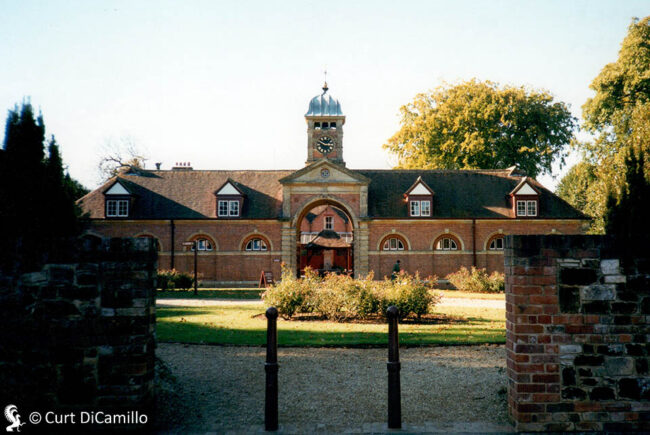
The stableblock
Earlier Houses: There was an earlier Medieval house near the site of the current house.
Built / Designed For: Sir Ralph Bankes
House & Family History: Sir Roger Pratt, who designed the house (then called Kingston Hall) in the mid-17th century, was clearly channeling his earlier Coleshill House, Oxfordshire (see "Images" section). In the 19th century Sir Charles Barry altered Kingston Lacy House considerably, leaving it as seen today. In 1905 Edward VII visited Kingston Lacy; while walking through the park he sprained his ankle in a rabbit hole and had to be hauled to the tree-planting ceremony in a pony chaise. The Kingston Lacy Estate, which covers 16,000 acres and includes Corfe Castle, was donated to the National Trust in 1981.
Collections: Kingston Lacy contains an exceptionally fine collection of paintings, including 10 Lelys, three Lawrences, three van Dycks, four works by Brueghel the Younger, one Titian (Nicolo Zen), one Velásquez (Cardinal Camillo Massimi), and two portraits by Rubens: Sir John Bankes, who built Kingston Hall, and the Marchesa Maria Grimaldi. There are also other important canvases in the collection, including “The Judgement of Solomon” by Sebastiano del Piombo, “The Woodley Family” by Zoffany, Henry Bankes the Younger by Batoni, Anne, Lady Falmouth, by Sir Thomas Lawrence, and Frances Woodley by George Romney. The collection includes two important mid-19th century life-sized bronze sculptures (“Brave Dame Mary” and Charles I) by Pietro Carlo Giovanni Battista Marochetti. William John Bankes, a friend of Byron’s who traveled extensively in Asia and the Middle East, collected most of Kingston Lacy’s antiquities and formed the largest private collection in the world of ancient Egyptian art and artifacts. Two of the most important pieces in the collection of ancient art are the circa 25 BC—circa 15 AD Egyptian black Basanite portrait bust of a Roman (possibly Mark Antony) and the Philae Obelisk. The latter, discovered by W.J. Bankes in 1815, stands on the south lawn of the house. It was one of a pair of twin pink granite obelisks erected at Philae, in Upper Egypt, in the 2nd century BC; its Egyptian and Greek hieroglyphic inscriptions were instrumental in the decipherment of ancient Egyptian hieroglyphs. Please see the PDF in the "Related Resources" section for the mid-1950s notes and lists of Cornelius Clarkson Vermeule III, the late scholar of ancient art and classical curator at the Museum of Fine Arts, Boston, on the collection of ancient art at Kingston Lacy. In 1841, after being ensnared in his second homosexual scandal (if convicted, he would almost certainly have, at minimum, spent the rest of his life in prison), William John fled England for Italy, where spent the rest of his life. He continued to furnish Kingston Lacy from afar and became one of the world’s foremost experts on colored marble (which is why Kingston Lacy has an unusually large number of items made of rare, Italian colored marbles). Though rumors had long suggested that he snuck back into England to see how his beloved house was coming, this was discounted until Anne Sebba discovered his drawings and notes, unpublished and forgotten, at Kingston Lacy in the late 20th century. She published her findings in the 2005 groundbreaking book, "The Exiled Collector: William Bankes and the Making of an English Country House," which established that William John visited Kingston Lacy at least twice (incognito) while he was in exile in Italy.
Garden & Outbuildings: The Philae Obelisk that is today on the grounds of Kingston Lacy was originally one of a pair of twin columns erected in the 2nd century BC at the Temple of Isis at Philae in Upper Egypt. Discovered in 1815 by William John Bankes, the Kingston Lacy obelisk is the only survivor (its twin was lost in antiquity). The Greek and Egyptian hieroglyphic inscriptions on the obelisk played a role in the decipherment of ancient Egyptian hieroglyphs. See the "Images" section for a photo of an 1820s miniature red stone model of the Philae Obelisk that is today in the collection of the British Museum. The park contains a herd of Red Devon cattle. In 2024 the National Trust announced that, in one of its biggest heat pump projects, Kingston Lacy's oil boilers had been replaced by a ground source heat pump system that will save the National Trust almost 8,000 gallons of oil per year.
Architect: William Rice
Date: 1770sArchitect: Thomas Henry Wyatt
Date: 1880Architect: Robert William Furze Brettingham
Date: 1784-89Architect: Charles Barry Sr.
Date: 1835-41John Preston (J.P.) Neale, published under the title of Views of the Seats of Noblemen and Gentlemen in England, Wales, Scotland, and Ireland, among other titles: Vol. I, 1818.
Country Life: XV, 558, 1904.
Title: Kingston Lacy Guidebook
Author: NA
Year Published: 1998
Reference: pgs. 34-35
Publisher: London: The National Trust
ISBN: 0707802253
Book Type: Softback
Title: Biographical Dictionary of British Architects, 1600-1840, A - HARDBACK
Author: Colvin, Howard
Year Published: 2008
Reference: pgs. 101, 829, 861
Publisher: New Haven: Yale University Press
ISBN: 9780300125085
Book Type: Hardback
Title: Disintegration of a Heritage: Country Houses and their Collections, 1979-1992, The
Author: Sayer, Michael
Year Published: 1993
Publisher: Norfolk: Michael Russell (Publishing)
ISBN: 0859551970
Book Type: Hardback
House Listed: Grade I
Park Listed: Grade II
Past Seat / Home of: SEATED AT EARLIER HOUSE: John Beaufort, 1st Marquess of Somerset, 1st Marquess of Dorset, and 1st Earl of Somerset, 14th century. Charles Blount, 1st Earl of Devonshire, 1603-06. Sir John Bankes, 1634-44; Sir Ralph Bankes, 1644-64. SEATED AT CURRENT HOUSE: Sir Ralph Bankes, 1664-77; John Bankes the Elder, 1677-1714; Henry Bankes the Elder, 1714-76; Henry Bankes the Younger, 1776-1834; William John Bankes, 1834-55; George Bankes, 1855-56; Edmund George Bankes, 1856-60; Henry John Percival Bankes, 1860-69; Walter Ralph Bankes, 1869-1904; Henry John Ralph Bankes, 1904-81; Bankes family here from the 1630s until 1981.
Current Ownership Type: The National Trust
Primary Current Ownership Use: Visitor Attraction
House Open to Public: Yes
Phone: 01202-883-402
Fax: 01202-882-402
Email: [email protected]
Website: https://www.nationaltrust.org.uk
Historic Houses Member: No